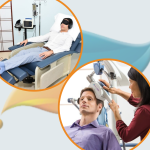If you or someone you love has identified that you have an eating disorder, it can be both overwhelming and anxiety-provoking to know where exactly to begin. It is important to note that change can be scary, like all transitions. Having an idea of what stages of change look like can make it easier to support someone through the process of getting help:
Precontemplation: A loved one may notice drastic weight loss or behavioral habits around eating. Still, when they bring it to the person’s attention, they are typically met with anger, defensiveness, and denial around the topic.
TIP: Keep in mind that an eating disorder is used as a coping skill to maintain control and to manage heavy emotions. If discussing food patterns causes an intense response, show compassion, and talk more about life goals and dreams and how restricted behaviors may affect this.
Contemplation: It is when the realization that their behavior or weight is a problem. Typically, motivation to change fluctuates, and the person may appear to flip-flop in wanting to get help.
TIP: Keep in mind that it means letting go of the only method they know to help maintain control. Be an active listener and reflect and encourage thoughts about getting help.
Preparation and Determination: It is an active decision to change, and support is needed. It includes planning and looking at the kind of support required. High anxiety during is common.
TIP: Being educated on the kind of support needed makes this process a little bit easier, especially when a person identifies their goals (this is also the point of this blog).
Action: When we see the most behavior change, which can vary depending on the level of care needed. It includes unlearning maladaptive behaviors that maintain the problem.
TIP: Remember that progress is not linear, and a person may take steps forward and back with relapses in between. Continue to encourage the person and let them know that they’re doing the right thing.
Maintenance: We see a notable change in behavior, and the focus now becomes more about utilizing healthy habits instead of old habits.
TIP: Relapses can still happen, be patient, and help the person identify triggers and link to support to manage them daily.
While these stages of change can clarify where a person is, a person can go back and forth in scenes throughout this process.
Levels of care
Because eating disorders affect people at different severities and rates, it is essential to note that not everyone follows the same track to recovery. Time and intensity of support vary from person to person. Below we discuss the significant steps in support:
Medical Stabilization: The recommendation of medical stabilization is when a person is displaying dangerously low weight or medically compromised due to extended restriction and starvation. There is an increased risk of Refeeding syndrome, complicating the recovery process. Patients who meet this criterion typically display:
- A weight that falls below the 70th percentile of body weight
- A BMI that is less than 15
- Hypothermia
- Low Potassium, phosphates, and abnormal electrolyte numbers
- Abnormal vital signs include irregular heart rate, heart failure, low blood pressure
- Loss of consciousness due to drops in blood pressure
- Liver or Kidney Failure
Residential Treatment: Residential treatment is the next step to medically stabilizing a patient. It includes medical, psychiatric, and therapeutic support, including group therapy, normalizing healthy eating routines, and behavior modification. According to NEDA, they recommend residential treatment when a person becomes medically stable but exhibits the following:
- A need for assessment of mental health.
- Eating disorder disrupts executive functioning and prevents a person from functioning normally in social, vocational, and or educational settings.
- Continues to exhibit daily behaviors to maintain weight control, including binging, purging, food restriction, and other weight control techniques.
Intense Outpatient Treatment (IOP): In this stage of treatment, 360 care is provided with a case manager, therapist, nutritionist, and group therapy so that a person can take the skills learned and apply them to their home environment. This treatment aims to provide education on nutrition, learn coping skills to replace disordered thoughts, and work through triggers that impact the rate of success.
Continuation of outpatient support: The coordination of care and previous support is essential for continued success. Psychotherapy is continued in conjunction with a nutritional therapist and psychiatrist, if applicable, with a great deal of communication to ensure seamless support. Treatment methods may include motivational interviewing, cognitive-behavioral therapy (CBT), and dialectical behavior therapy (DBT). Here at Gateway to Solutions, we understand that the first step to reaching out to a therapist after a challenging process can feel daunting; for some help, check out our blog: 5 Easy Steps to Start Therapy. We are here to support and join you at this pivotal part of treatment.



